| Diese Seite auf Deutsch! |
|
Neopilina and Its RelativesMonoplacophora Odhner, 1940 (Synonyms: Tryblidiacea Wenz, 1938, in Lemche, 1957; Tryblidia Lemche, 1957) |
|
 |
||||||||||||||||||||||||||||||||
| Number of species in Mollusca, displayed by classes, including percentage. Sources: WoRMS: MolluscaBase eds. (2025): Mollusca LINNAEUS, 1758. | |||||||||||||||||||||||||||||||||
 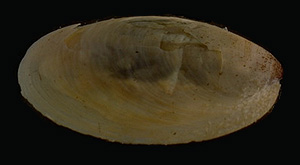 Dorsal view of Neopilina galatheae. Below: Lateral view. Source: Monoplacophora (Univ. Mich. Mus. Zool. 1995). |
Several inconspicuous limpet-like creatures about 3 cm in size had been collected from a depth of 3750 m. At first, the specimens were kept in storage, to be later examined by specialists. The results of the examination, published by the Danish zoologist H. Lemche 1957 in a paper, surprised the scientific world:
Not only the small molluscs definitively were not limpets: in contrary, they belonged to a group of molluscs so far only known as fossils and extinct since the Devonian period, 375 million years ago. After a fossil genus from that group, Pilina, Lemche called the newly discovered mollusc Neopilina - the new Pilina.
![]() Lindberg,
D.R. (2009): "Monoplacophorans and the origin and relationships of mollusks".
Evolution: Education and Outreach. 2 (2): 191–203. (PDF).
Lindberg,
D.R. (2009): "Monoplacophorans and the origin and relationships of mollusks".
Evolution: Education and Outreach. 2 (2): 191–203. (PDF).![]() Geological Time Periods (Time
Table).
Geological Time Periods (Time
Table).
Looking at Neopilina from a dorsal point of view, it apparently does look like a limpet: A cup shaped shell covers the entire dorsal side of the animal. In one specimen, even rests of the primordial spire could be found, so Neopilina's shell seemed to be coiled like that of a gastropod.
But from a closer point of view, Neopilina was not that inconspicuous: The shell tip points to the front, not to the side or to the rear like in all gastropods. The only known extant mollusc with a shell coiled to the front is Nautilus, a cephalopod. Cross-sections through the shell of Neopilina showed it to be a true mollusc shell with the known tripartite vertical build of the wall. Like in other molluscs, the shell is produced by cells in the dorsal epidermis, the mantle (pallium).
Source: Biodidac, modification: R. Nordsieck. |
Yellow: Neural System; Orange: Exkretion Organs; Red: Heart and Gills; Dark Red: Musculature. |
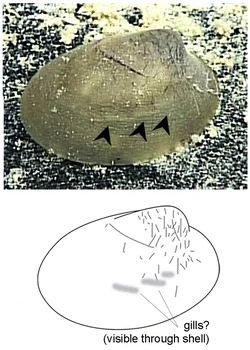 Neopilina sp., animal crawling to the right. Source: Sigwart, J.D. et al. (2019) (Link). |
The neural system of Neopilina also looks rather ancient: There are two lateral neural pathways: a pleural nerve (mantle nerve) and a pedal nerve (foot nerve). They join at the animal's posterior end to each form a closed neural ring. Between them, both neural rings are linked by transversal connections (connectives), the result being a rope-ladder shaped nervous system, as it is known from arthropods. Neopilina has no visible neural knots (ganglia).
As a summary, Neopilina displays highly evolved (derived) characters, but also ancient ones. The shell on one hand does qualify Neopilina as a highly developed mollusc like other shell-bearing ones (Conchifera), such as gastropods and bivalves, as opposed other molluscs, such as chitons (Polyplacophora) and the shell-less molluscs ("Aplacophora"), such as solenogasters and caudofovetans, which have not developed a complete shell yet, but instead rely on calcareous scales or spicules for their protection. On the other hand, in Neopilina's anatomy, there are also several characters appearing rather ancient, more resemblant that of the just mentioned Polyplacophora, Caudofoveata and Solenogastres, from which Neopilina remains distinctly different due to its derived shell.
After Lemche's publications in 1957 the scientific world generally assumed to have found a missing primordial mollusc, Neopilina thus being a living fossil. What contradicts this, is especially the distinctly derived conchiferan shell, so today it is assumed that the other Conchifera, as well as the Monoplacophora class with Neopilina and its relatives extinct since the Devonian period, have evolved from common ancestors.
The Monoplacophora are presumed to have split off the evolutionary line early, which explains the combination of derived conchiferan characters and ancient mollusc characters. However, the annelid-type characters of these ancient molluscs (such as the rope-ladder type nervous system and the serial nephridia) today are deemed to be derived or newly developed.
Systematics
Today, in the class Monoplacophora, apart from 4 fossil orders, only one extant order, Neopilinida with about 25 extant species, is listed.
Class: Monoplacophora Odhner, 1940
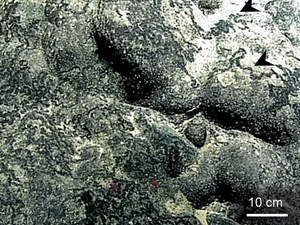 Feeding tracks of Neopilina sp. on "Utu" sea mountain near American Samoa. |
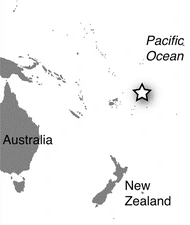 Location of the "Utu" sea mountain. |
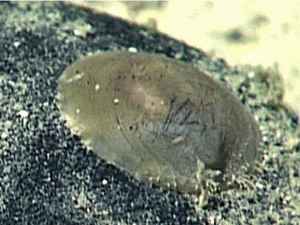 Neopilina sp. on "Utu" sea mountain in a depth of 3837 m. Source: Sigwart, J.D. et al. (2019) (Link). |
![]()
![]() Order: Neopilinida Lauterbach, 1983
Order: Neopilinida Lauterbach, 1983
![]()
![]() ÜberFamily: Neopilinoidea Knight & Yochelson,
1958
ÜberFamily: Neopilinoidea Knight & Yochelson,
1958
![]()
![]() Family: Neopilinidae Knight & Yochelson,
1958
Family: Neopilinidae Knight & Yochelson,
1958
![]()
![]() Subfamily: Neopilininae Knight & Yochelson,
1958
Subfamily: Neopilininae Knight & Yochelson,
1958
![]()
![]() Genus:
Adenopilina Starobogatov & Moskalev,
1987
Genus:
Adenopilina Starobogatov & Moskalev,
1987
![]()
![]() Genus:
Laevipilina J. H. McLean,
1979
Genus:
Laevipilina J. H. McLean,
1979
![]()
![]() Genus:
Monoplacophorus Moskalev, Starobogatov
& Filatova, 1983
Genus:
Monoplacophorus Moskalev, Starobogatov
& Filatova, 1983
![]()
![]() Genus:
Neopilina Lemche, 1957: Neopilina
galatheae Lemche, 1957
Genus:
Neopilina Lemche, 1957: Neopilina
galatheae Lemche, 1957
![]()
![]() Genus:
Vema A. H. Clarke & Menzies,
1959
Genus:
Vema A. H. Clarke & Menzies,
1959
![]()
![]() Subfamily: Veleropilininae Starobogatov & Moskalev,
1987
Subfamily: Veleropilininae Starobogatov & Moskalev,
1987
![]()
![]() Genus:
Micropilina Warén, 1989
Genus:
Micropilina Warén, 1989
![]()
![]() Genus:
Veleropilina Starobogatov & Moskalev,
1987
Genus:
Veleropilina Starobogatov & Moskalev,
1987
![]()
![]() Order: Sinuitopsida (fossil)
Order: Sinuitopsida (fossil)
![]()
![]() Subclass: Tergomya (fossil)
Subclass: Tergomya (fossil)
![]()
![]() Order: Tryblidiida (fossil)
Order: Tryblidiida (fossil)
![]() Source:
MolluscaBase eds. (2025).
Monoplacophora Odhner, 1940.
Source:
MolluscaBase eds. (2025).
Monoplacophora Odhner, 1940.
Latest Change: 01.10.2025 (Robert Nordsieck).